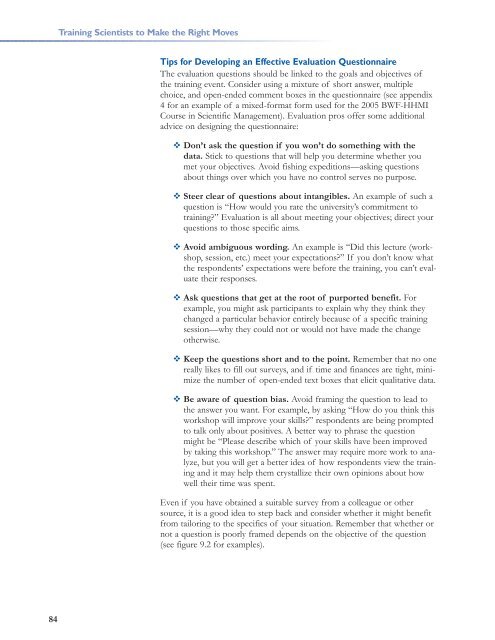Training Scientists to Make the Right Moves - Howard Hughes ...
Training Scientists to Make the Right Moves - Howard Hughes ...
Training Scientists to Make the Right Moves - Howard Hughes ...
Create successful ePaper yourself
Turn your PDF publications into a flip-book with our unique Google optimized e-Paper software.
<strong>Training</strong> <strong>Scientists</strong> <strong>to</strong> <strong>Make</strong> <strong>the</strong> <strong>Right</strong> <strong>Moves</strong><br />
Tips for Developing an Effective Evaluation Questionnaire<br />
The evaluation questions should be linked <strong>to</strong> <strong>the</strong> goals and objectives of<br />
<strong>the</strong> training event. Consider using a mixture of short answer, multiple<br />
choice, and open-ended comment boxes in <strong>the</strong> questionnaire (see appendix<br />
4 for an example of a mixed-format form used for <strong>the</strong> 2005 BWF-HHMI<br />
Course in Scientific Management). Evaluation pros offer some additional<br />
advice on designing <strong>the</strong> questionnaire:<br />
Don’t ask <strong>the</strong> question if you won’t do something with <strong>the</strong><br />
data. Stick <strong>to</strong> questions that will help you determine whe<strong>the</strong>r you<br />
met your objectives. Avoid fishing expeditions—asking questions<br />
about things over which you have no control serves no purpose.<br />
Steer clear of questions about intangibles. An example of such a<br />
question is “How would you rate <strong>the</strong> university’s commitment <strong>to</strong><br />
training?” Evaluation is all about meeting your objectives; direct your<br />
questions <strong>to</strong> those specific aims.<br />
Avoid ambiguous wording. An example is “Did this lecture (workshop,<br />
session, etc.) meet your expectations?” If you don’t know what<br />
<strong>the</strong> respondents’ expectations were before <strong>the</strong> training, you can’t evaluate<br />
<strong>the</strong>ir responses.<br />
Ask questions that get at <strong>the</strong> root of purported benefit. For<br />
example, you might ask participants <strong>to</strong> explain why <strong>the</strong>y think <strong>the</strong>y<br />
changed a particular behavior entirely because of a specific training<br />
session—why <strong>the</strong>y could not or would not have made <strong>the</strong> change<br />
o<strong>the</strong>rwise.<br />
Keep <strong>the</strong> questions short and <strong>to</strong> <strong>the</strong> point. Remember that no one<br />
really likes <strong>to</strong> fill out surveys, and if time and finances are tight, minimize<br />
<strong>the</strong> number of open-ended text boxes that elicit qualitative data.<br />
Be aware of question bias. Avoid framing <strong>the</strong> question <strong>to</strong> lead <strong>to</strong><br />
<strong>the</strong> answer you want. For example, by asking “How do you think this<br />
workshop will improve your skills?” respondents are being prompted<br />
<strong>to</strong> talk only about positives. A better way <strong>to</strong> phrase <strong>the</strong> question<br />
might be “Please describe which of your skills have been improved<br />
by taking this workshop.” The answer may require more work <strong>to</strong> analyze,<br />
but you will get a better idea of how respondents view <strong>the</strong> training<br />
and it may help <strong>the</strong>m crystallize <strong>the</strong>ir own opinions about how<br />
well <strong>the</strong>ir time was spent.<br />
Even if you have obtained a suitable survey from a colleague or o<strong>the</strong>r<br />
source, it is a good idea <strong>to</strong> step back and consider whe<strong>the</strong>r it might benefit<br />
from tailoring <strong>to</strong> <strong>the</strong> specifics of your situation. Remember that whe<strong>the</strong>r or<br />
not a question is poorly framed depends on <strong>the</strong> objective of <strong>the</strong> question<br />
(see figure 9.2 for examples).<br />
84
















